As an Amazon Associate I earn from qualifying purchases.
If there is a bedrock duck breasts recipe, it is this one. One of the most common requests I get from readers is for step-by-step instructions on how to cook a duck breast properly. And this same technique works for goose breasts, as well as any other dark meat bird breasts, like pigeons, sharp-tailed grouse and the like.
Here’s how to go about it.
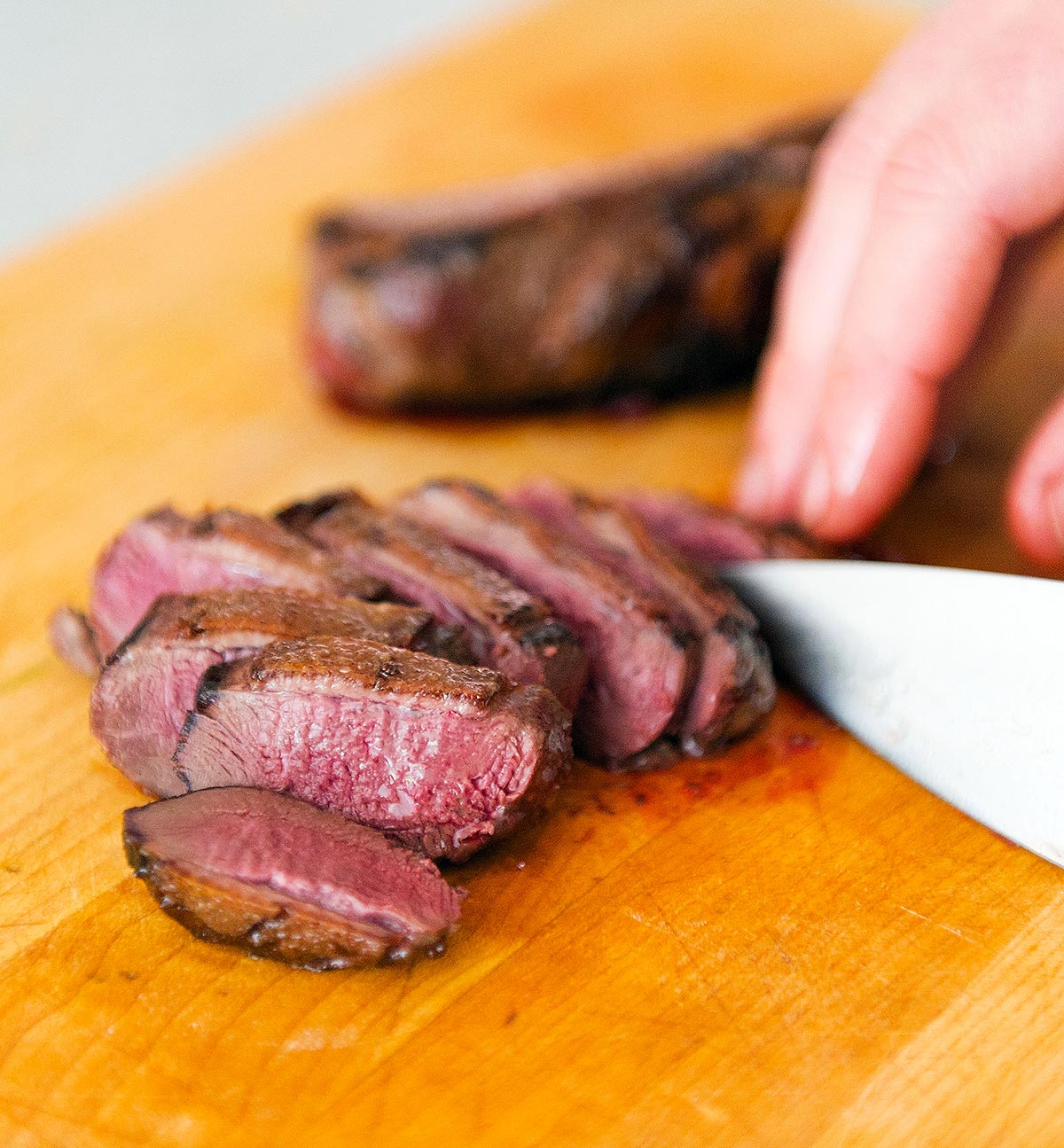
I know, some of you are thinking, “I know how to do this already, Hank.” To you I apologize; what’s more, my method is idiosyncratic and is likely to be different from yours — but it works. Every time. I’ve cooked thousands of duck breasts, and that’s no exaggeration, and this is how I cook a duck breast.
So for everyone else, here goes.
A few things before we start. First off, a duck breast is supposed to be cooked like a steak, which is to say rare to medium. That means the proper internal temperature of a duck breast, after the meat rests, is between 125°F and 140°F. No one will stone you to death if your duck breast hits 145, but anything over that and, well, you kinda wrecked it.
But aren’t ducks poultry, and shouldn’t that be cooked to 165°F? Yes, ducks are birds. But they are red meat birds, and should be cooked like beef. Doing research for my cookbook on cooking ducks and geese, Duck, Duck, Goose: Recipes and Techniques for Cooking Waterfowl, Both Wild and Domesticated, I combed through years and years of data on food borne illness from the CDC and found almost no instances of it in ducks and geese.
Hell, you can even eat duck tartare if you want. And I do.
So any duck breasts recipe that tells you to cook the hell out of the meat is either very old — we used to overcook duck on the regular, which is why so many people hated it — or the creator of that recipe has a thing against great tasting meat. Because if you know how to cook duck breast properly, you’ve basically succeeded in making a steak wearing a hat made of bacon.
About that “bacon.” That’s the skin, so be sure to have breasts with skin on them. Skinless breasts require a different set of instructions. I go over those instructions in my cookbook if you’re interested, but the short version is that a skinless duck breast cooks exactly like a similarly sized piece of steak.
Detailed, and I mean very detailed, instructions are below in the recipe. (I’ve also put together a video for this particular duck breasts recipe.) Follow them and you will soon be able to cook a duck breast in your sleep.
Before you get there, though, I’ll walk you through it quickly. First you want to let your duck breasts come to room temperature. Take them out of the fridge and salt them, then let everything sit for 30 minutes or so. Pat them dry with paper towels.
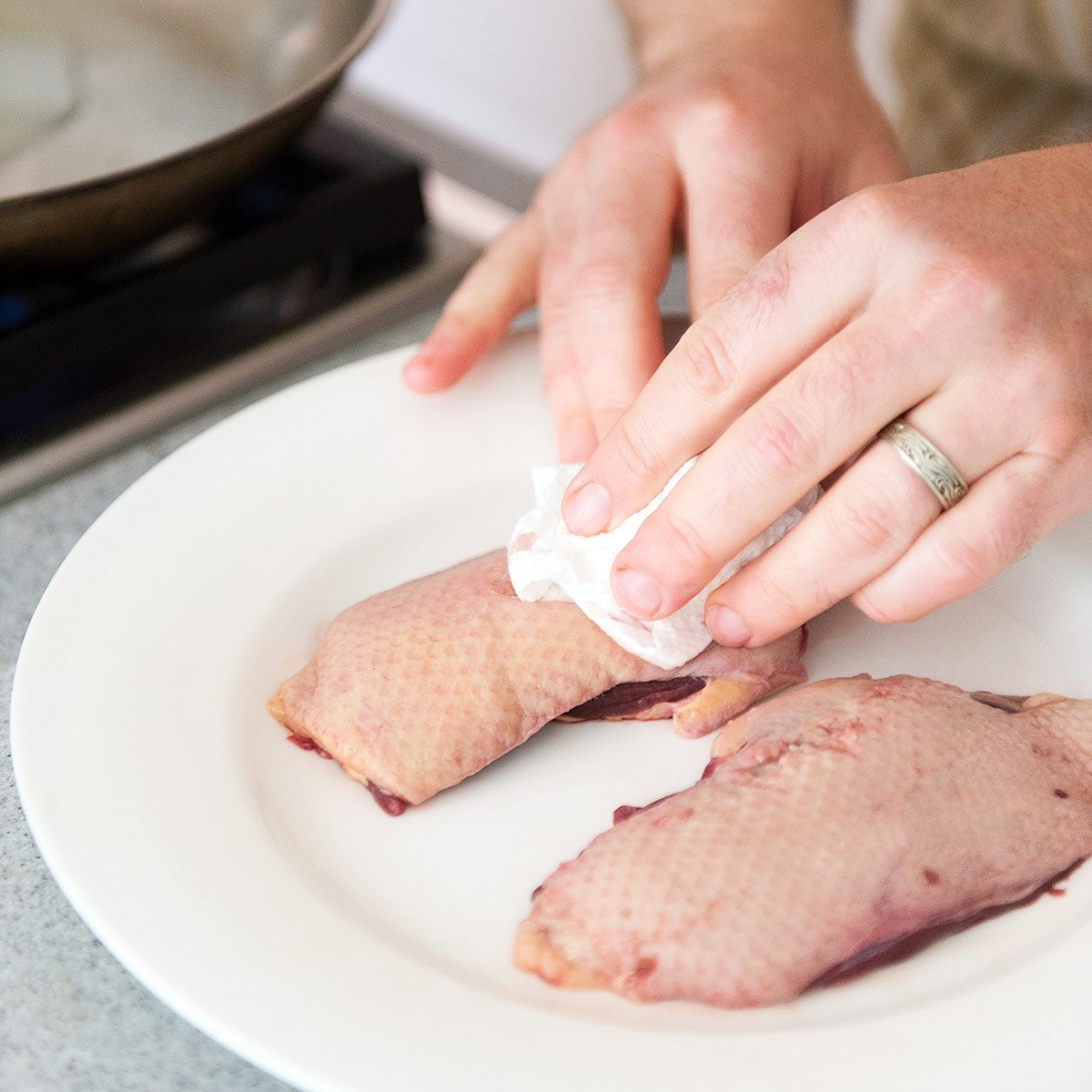
With a duck breast like this one (it’s a fat pintail duck I hunted here in NorCal), or fatter, you won’t need much fat or oil to start in the pan. I almost always use rendered wild duck fat (here’s how to render duck fat at home), but you can buy duck fat, too. It’s not 100 percent needed, though. You can start cooking duck breasts with a little oil, lard or butter, too.
Heat a steel or iron pan — non-stick doesn’t like the high heat we’ll be cooking duck breasts in — over medium-high heat, and just melt the fat. Use a duck breast to smear it around the pan.
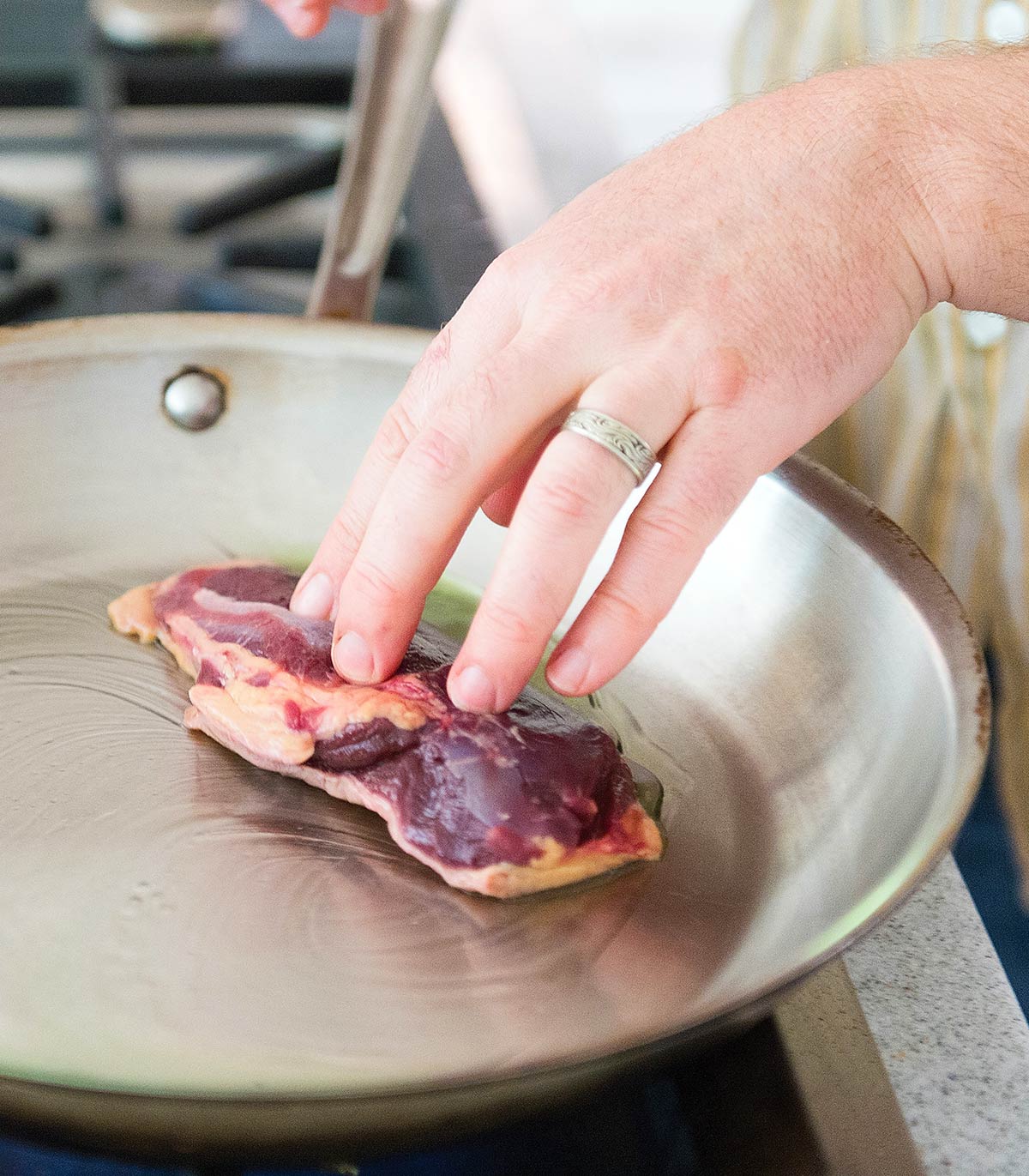
Set down the remaining duck breasts (I find I can do about four or five at a time), and let them heat up. If you set duck breasts down in a pan that’s too hot, the skin will contract very quickly and you will get this little oval indentation near the thin end of the breast that won’t crisp.
Regardless, it’s a good idea to use your tongs to press down on this part for about a minute, so it relaxes and gets good contact with the pan. A bacon press works well, too.
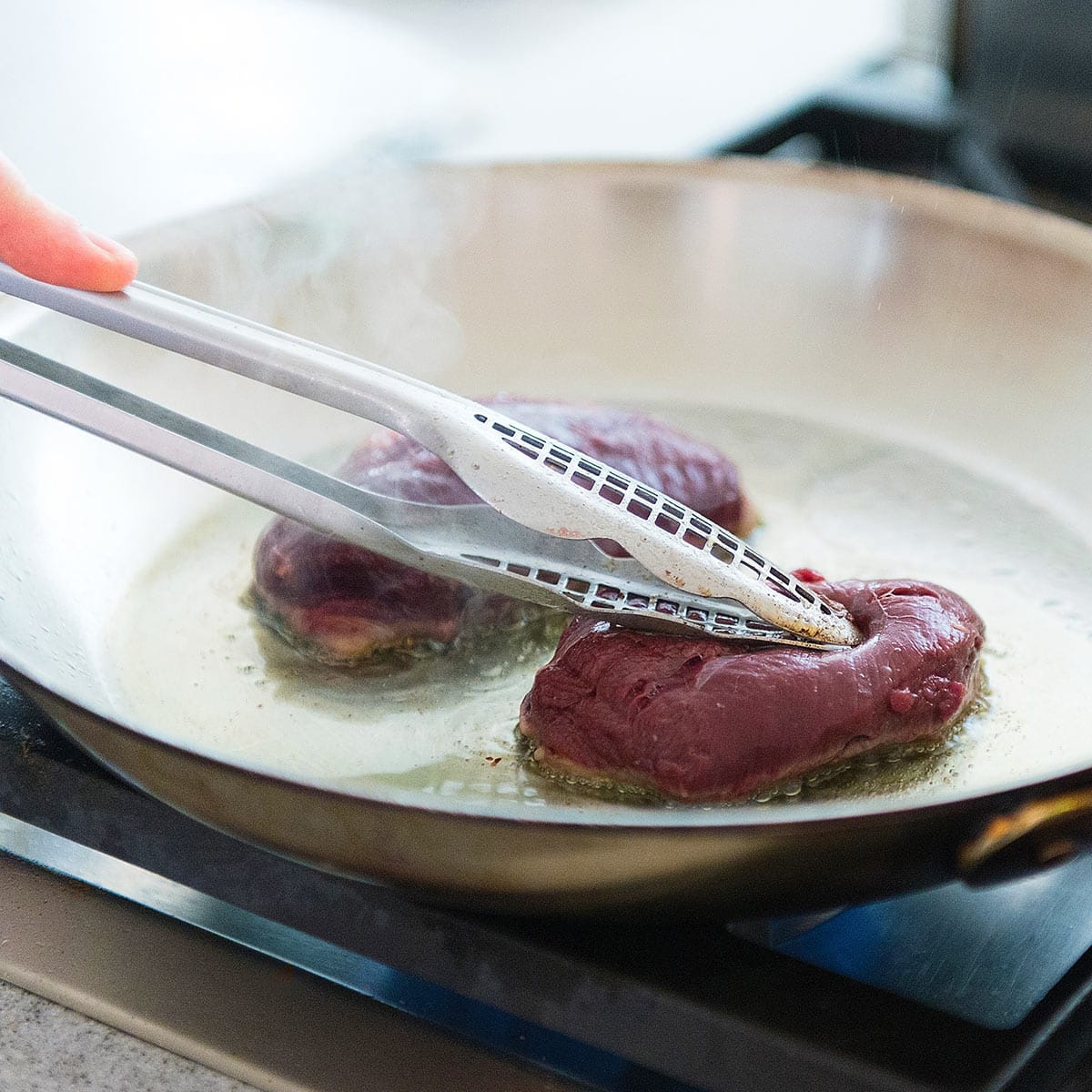
One secret of cooking duck breast is to let it cook about three-quarters of the time on the skin side. This renders most of the fat and crisps the skin, which serves as a barrier to the meat, so that side won’t get overcooked.
You flip the breasts when the skin is browned and crispy — and yes, you can look — then let them cook on the meat side for a few minutes. I have some guidelines for various types of ducks in the recipe card below.
Finally, you want to kiss the fat sides of the duck breasts by standing them up against each other. This is a trick I learned from cooking morbidly obese mallards and pintails that had been living in the California rice fields, and it works well with store-bought ducks, too.
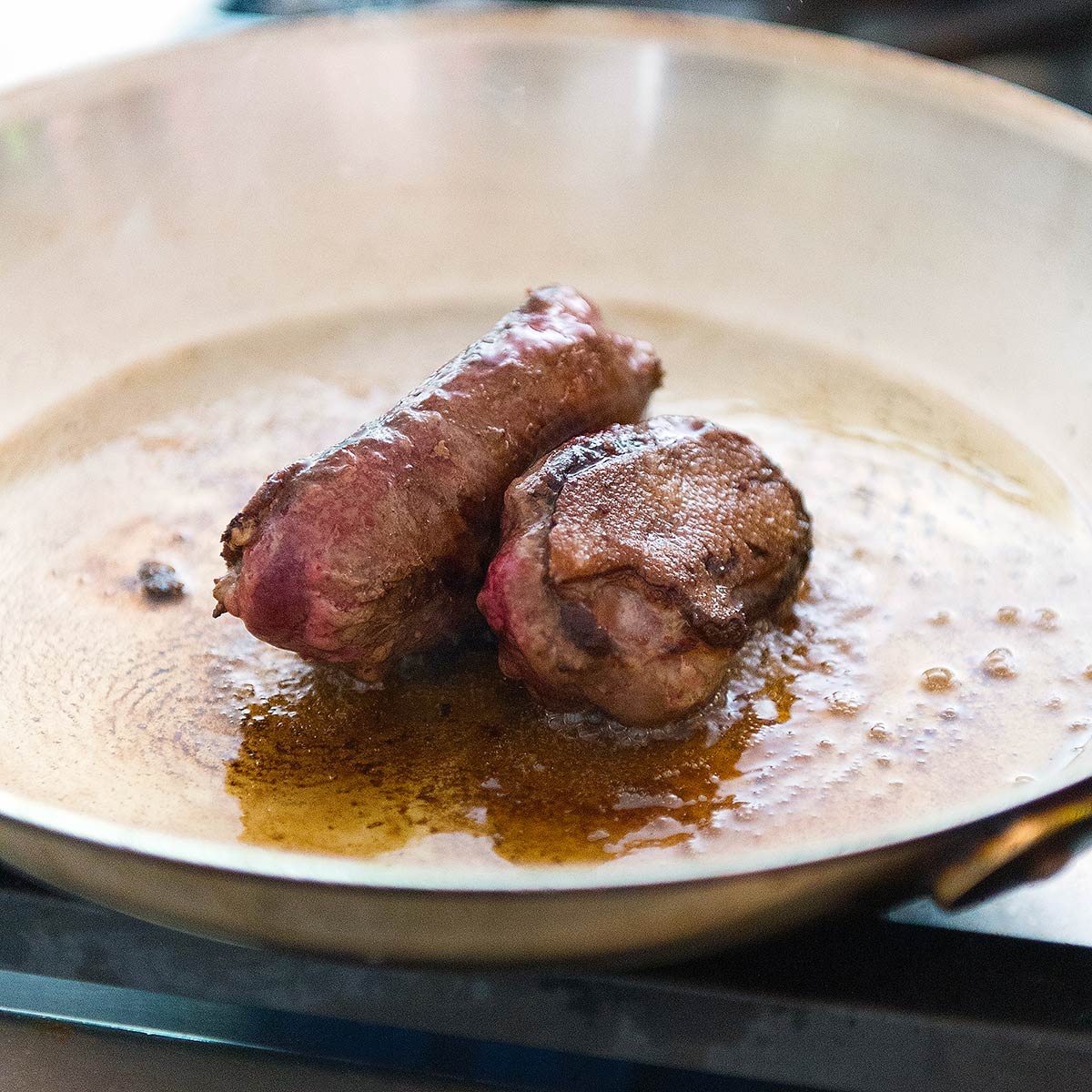
Finally, let your duck breasts rest on a cutting board, skin side up. If they are a little underdone, you can tent them with foil, but I rarely do that because it damages your crispy skin. I do like to grind black pepper over the skin as it rests, though.
Bottom line: this is the duck breast recipe I follow almost exclusively: I really don’t think a nice fat pintail or mallard or wood duck needs more than salt, pepper and a squeeze of citrus or vinegar or a dash of Worcestershire.
That said, I have a long list of wild game sauces here, and many go well with duck. I also have a number of specific recipes that use this technique for cooking duck breasts here on the site, such as:
- Duck breasts with a Nordic beer sauce.
- German duck with turnips and spätzle.
- Old school duck bigarade, a precursor to French duck a l’orange.
- A homey dish of duck breast with apples.
How to Cook a Duck Breast
Ingredients
- 4 duck breasts (breasts from two ducks)
- Salt
- 1 teaspoon duck fat or olive oil
Instructions
- Take the duck breasts out of the fridge. If you are using a domestic duck or a very fat wild duck, score the skin (but not the meat) in a cross-hatch pattern, making the cross-hatches about 1/2 inch across; this helps the fat render and will give you a crispier skin. Salt it well on both sides, then let it sit on a cutting board for at least 15 minutes and up to 45 minutes for a goose breast.
- Pat the duck breasts dry with paper towels. If you are cooking a domestic duck or a very fat wild duck, put 1 teaspoon of duck fat or cooking oil in a large pan; Lay the breasts skin side down and use them to smear the fat all over the surface of the pan. Turn the heat to medium-high. Yes, you read that right: Don't preheat the pan. You want as much fat to render out as possible, so start with a cool pan. If you are working with normal wild duck breasts, i.e., skinny ones, heat the pan over high heat for 1 minute, then add 2 tablespoons of duck fat, lard or some other oil. Let this get hot, but do not let the fat smoke. Only then do you lay the duck breasts in the pan, skin side down. Either way, once the duck breasts start cooking, you will notice the "tails" of skin and fat from the head and the tail side of the fillet contract immediately. As the skin contracts, you will sometimes get a little oval patch on the tail end of the breast that curls up and doesn't make contact with the pan. Use your tongs to press down on this part for 30 to 60 seconds. This gives you a more even sear.
- Let the pan do its job. Cook at a jocular sizzle -- not an inferno, not a gurgle. Think about how bacon sounds in the pan when you cook it, and you have the right idea. How long? It depends. I like my duck medium-to-medium-rare. To do this with small ducks like teal or ruddy ducks, you need only about 3 minutes on the skin side, and you might want to keep the heat higher. Medium-sized ducks like wigeon, gadwall or wood ducks need 3 to 5 minutes. Mallards, pintail, canvasbacks and domestic ducks need between 5 and 8 minutes. If you are cooking a goose breast, you will want the heat on medium-low and you'll need to cook the skin side a solid 10 to 12 minutes. The key is to let the breast do most of its cooking on this side -- it's the flattest, and will give you that fabulously crispy skin we all know and love. Again, I repeat: When you cook a duck breast, 3/4 of the total cooking time is on the skin side.
- Turn the breasts over. When? Follow the guidelines above, but also use your ears: You will hear the sizzle change; it will die down, just a bit. That's when you turn. Lightly salt the now-exposed skin immediately. Doing this seems to absorb any extra oil and definitely gives you an even crispier skin. Let the ducks cook on the meat side for less time. I recommend: 1 to 2 minutes for small ducks; 3 to 4 minutes for medium ducks; 4 to 6 minutes for large wild ducks and domestic duck; 5 to 7 minutes for geese. More than mere time, however, you need to just use The Force to know when your duck is ready. Not in tune with The Force? The next best thing is the finger test for doneness. Use this to determine when you're almost ready. My advice is to go to the next step when your duck breasts are rare.
- Now "kiss" the thick side of the breasts by standing two halves against each other. You will notice that duck and goose breasts plump up and contract as they cook. One side of the fillet will be wider than the other, and this side will need some heat. Just tip the breasts on their sides and cook for 30 to 90 seconds, just to get some good color.
- Take the duck off the heat and let it rest on a cutting board, skin side up. This would be a good time to grind black pepper over it. Teal need only need a minute or two rest, while big Canada geese might need 10 minutes. Everything else benefits from about a 5 minute rest. A duck breast is just like a steak: If you don't rest it, the juices will run all over your cutting board -- and not down your chin, where they should be. You can slice the breast from either end, either side up. You can get thinner slices by starting at the meat end, but you lose a little of the crispiness of the skin. If you are serving a whole breast, always serve it skin side up, with its sauce underneath.
Video
Notes
Keys to Success
- If you don't have rendered duck fat handy, here's how to render duck fat at home.
- It is far easier to control the internal temperature with a room-temperature breast than an ice-cold one. This is why you need to let the meat come closer to room temperature before cooking. The exception is with very small duck breasts, like with teal. These you want to cook cold so they don't overcook.
- Don't use non-stick pans, as they don't like the high temperatures you want to sear meat as well as steel or cast iron.
- It's worth repeating: The key is to let the breast do most of its cooking on this side -- it's the flattest, and will give you that fabulously crispy skin we all know and love.
- Rest your breast. At least for a few minutes, and up to 10 to even 15 minutes for a large goose breast.
- Skin side up, always. You worked hard for that crispy skin. Keep it off the cutting board helps preserve that.
Nutrition
Nutrition information is automatically calculated, so should only be used as an approximation.






Made this last night (my first time buying and cooking duck) with a D’Artagnan duck breast and it was absolutely delightful. The cooking times in the recipe perfectly yielded a med-rare to medium final product. I can’t think of a recipe that yields more wow factor for less work. Thanks!
I don’t know where i can get fresh duck breasts for this weekend’s saturday night dinner… I can get frozen breasts… what recommendations can you provide?
Steve: Whole Foods always has frozen ones. Otherwise, find a butcher shop or Asian market.
I’m cooking a domestic duck breast for supper tonight and needed a brush up on method. Thanks for the instructions. I’ll be using Maple Blueberry Balsamic dressing.
Im an old duck, I used to shoot a lot Ducks, Pheasants, Quail, Doves down in the San Joaquin Valley many years ago, now live in the Pacific Northwest and have been given two Canadians and a couple of Mallards by a guy that shoots on the farm where I live. I’ll be cooking a half breast tonight,(my wife doesn’t eat duck anymore… she used to) for the first time in maybe 40 years.
One suggestion. After plucking the breast, take out the wishbone. It’s a little chore that makes it much cleaner and easier to get a nicer piece of meat.
The eclectic sceptic,
Jack
Hank, You rule! A continual inspiration! Keep up the good work!
Justin
I cooked duck breast for my husband tonight for the first time ever. We used this method and it turned out perfect! That is quite a feat for me as I’m prone to overcooking and burning meat. We both devoured our share, and this is the first time I’ve seen my husband eat home cooked meat without dipping it in a sauce of some sort. Thank you!
Hank: I guess it is more rare than I thought. I did report it. It was banded on August 15, 2014, but records stated it was hatched in 2013 or earlier. It was banded in BAIE LAVALLIERE, YAMASKA, QUEBEC, CANADA. I shot it in central Maryland about 25 miles south of Gettysburg, PA. From what I can tell looking at online maps it traveled more than 600 miles south from where it was banded. No wonder the wings were tough. I bought your book during the book tour when you came through Washington, DC. I enjoyed meeting you. It was a hectic evening, as I am sure you recall… If you find yourself in Maryland, you’ve got a place to stay if you need one. Best- Will
Hank: I guess it is more rare than I thought. I did report it. It was banded on August 15, 2014, but records indicate it was hatched in 2013 or earlier. It was banded in BAIE LAVALLIERE, YAMASKA, QUEBEC, CANADA. I shot it in central Maryland about 25 miles south of Gettysburg, PA. From what I can tell looking at online maps it traveled more than 600 miles south from where it was banded. No wonder the wings were tough! I bought your book during your tour when you came through Washington, DC. I enjoyed meeting you. It was a hectic evening. I sure you recall. If you make it out to Maryland, you have a place to stay if you need one. Best- Will
Hank, I just wanted to share that I managed to shoot my first wild duck on new year’s eve. A Mallard male that was banded! Once I got it home I immediately consulted my signed copy of your book Duck, Duck, Goose, and decided to hang it for a day or two in my cellar beneath the front porch (perfect 46 degrees F. and +50 percent relative humidity). I used your wax method to pluck him and then took him apart using the excellent photographs and instruction. I slow roasted the legs and wings, and seared the breasts to medium rare in duck fat I rendered from the tail, neck skin, and wing tips. It was unbelievably good. Very crisp skin with rare meat. I pan fried the heart, liver, and gizzard. The feet are in the freezer much to my wife’s chagrin, and a few of the nicer under-wing feathers are on the bench for flys I will tie for spring trout fishing. Next time I will roast the legs and wings longer. They were still tough, but had good flavor. I went out again Saturday morning to hunt ducks along a local river, but saw nothing, so I turned the shotgun to the trees and brought home two nice grey squirrels instead. Happy New Year!
Will: Are kidding me!?! You shot a banded mallard as your FIRST ever duck!?!?! That’s literally like winning the lottery! Did you report it? How old was it and where was it banded?
I just discovered your site looking for goose recipes. Have you tried sous vide? easiest way to get perfect duck breasts every time. I cook the breast as 130 for an hour and then about 3 minutes on medium heat skin side and 90 seconds on the meat side.
Rob: I’m actually not a fan of it. I don’t like the texture. My method takes 10 minutes, too. 😉
Hank, I tried this tonight with a Black Duck and you’ve made me a believer. Never again will I breast out a duck without the skin. Crispy and medium rare – I thought I was at a restaurant.
The duck we get is often VERY fatty and as the fat renders out am I supposed to remove the fat as it cooks? If I don’t in a stainless steel skillet the duck is 1/2 covered in fat or more. I have done duck (4-5x) well in the past but I want restaurant-amazing… What am I missing? The duck is from a local store and marked as magret about a pound breast.
AD: Wow, that’s a lotta fat! Yeah, I’d pour it off. You’ll need to lower the heat, too, so the fat has time to render out fully.
The post from Cheryl on 12-15-14 mentions a jazzy sauce from your book.
Dede: Probably Duck, Duck, Goose then. There’s a link to it at the top of this page.
Which cookbook is the jazzy sauce in?
Dede: What sauce? There’s no sauce in this post. But if you are looking for some, I have a ton in Duck, Duck, Goose and you can find a few here: https://honest-food.net/wild-game/sauces-for-wild-game/
I just wanted to thank you for these instructions, I have just cooked the most fabulous domestic duck breast ever for Christmas, usually I cook meat instinctively but never having tackled duck before I found your advice spot on.
Help, my two boys harvested 3 Muscovy on our property. Two 4lb hens and one 7lb drake. Not knowing any better we skinned them all. The drake was processed for a whole roast and the hens were boned. My question is do we need to use bacon or something to protect the meat during the cooking process. Any help would be much appreciated as we will be serving them for Christmas dinner. Thanks Harley
Harley: Oh boy… Sadly, skinning them was a big mistake. That fat and skin are what make duck so special! Honestly, my advice would be to break them down completely and cook the breast meat exactly like a steak, i.e., medium-rare. The legs and wings I’d braise or put into a stew until the meat wants to fall off the bones, then pull away the bones and serve.
We’re processing our first ducks. Do we need to reach a specific temperature for food safety? We will all be enjoying it, including our toddler and 7 year old. I have been searching for safe cooking temps for homestead raised ducks, but can’t seem to find much info. I always cook them medium, but wasn’t sure if that was high enough to kill any nasties. I appreciate your videos and recipes! Thank you!
Ashley: Meat temperature? Medium should be fine. If your toddler can eat beef cooked medium, duck will be fine, too.
So what is the ideal finished temperature to aim for?
Matthew: Up to you. I highly recommend you skip the thermometer and use the finger test I link to. No need to pierce the meat. But if you absolutely must do so, it’s the same as beef: Rare is 130, medium 140. There will be a little bit of carry over – about 5 degrees – as the meat rests.
These undated instructions and photos should help anyone get the hang of your method much easier than the former ones. I need to get your cookbook. I have done goose breasts without their skin following your method and they have been good, not great like the ones with skin though. Really enjoy your comments and ideas. Unrelated to cooking ducks but do you ever cook a venison neck roast?
My husband Jeff fixed snow goose breast following these directions with the jazzy sauce from your book. We used apricot preserves for the sweet and rum for the spirits and it is one of the best three things we’ve ever eaten. Thanks